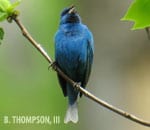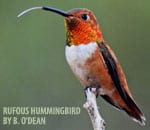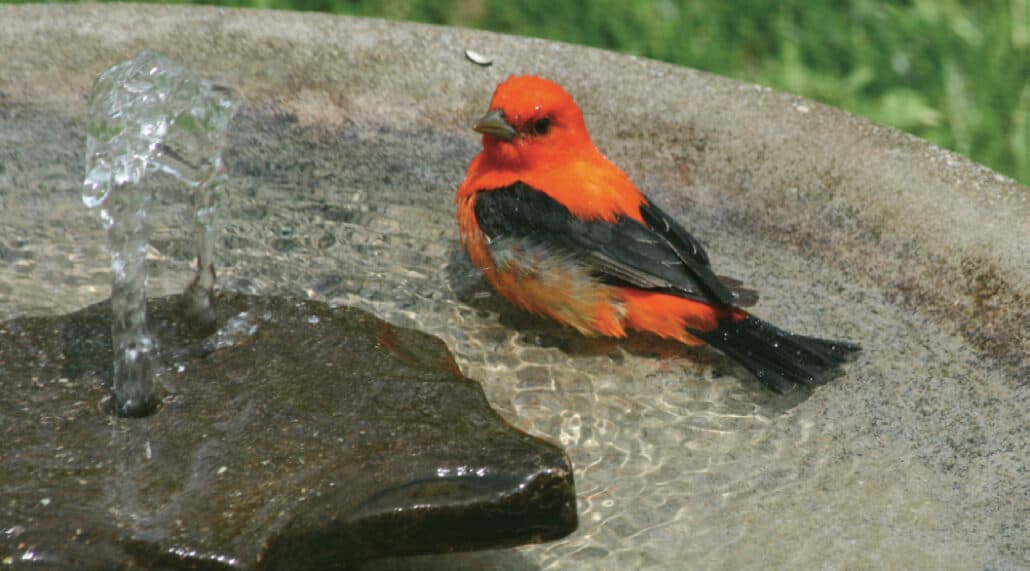Moving water in your backyard created by a mister or dripper is a fantastic way to attract birds. During spring and fall migration, when species not normally found in your area are passing through, an attractive birdbath can make them stop to bathe or drink. Make sure your bath is clean and in a spot where you can easily observe it throughout the day. Here are a few of the interesting birds to watch for at your birdbath.

Warblers. Many bird watchers consider warblers to be the stars of the show during spring and fall migration. Perhaps this is the number one reason to add a good water feature to your backyard. Warblers can be tricky to attract to feeders, but are easily lured into view with moving or running water. Among the many warbler species you might see in your backyard are yellow-rumped, Nashville, hooded, and redstart.
Looking for warblers? See a listing in our bird identification guide »

Rose-breasted grosbeak. If you live in the eastern two-thirds of the United States, you have a good chance of hosting one of these beauties in your backyard, especially during spring and fall migration. Rose-breasted grosbeaks love sunflower seeds, but they also love water. You’ll recognize the spring male by his stunning red, black, and white plumage. The female is streaky brown, resembling an over-sized female purple finch.
Learn more about the rose-breasted grosbeak »

Indigo bunting. These beauties are a welcome visitor to any backyard, and moving water is one of the best ways to keep them around. The males are actually black overall, but appear a brilliant deep blue when properly lit. Females are drab brown overall. These goldfinch-sized birds are common in the eastern two-thirds of the United States between spring and fall.
Learn more about the indigo bunting »

Painted bunting. No other North American bird sports the stunning splash of reds, blues, and greens like the adult male painted bunting. The females and young males are equally unique with their overall greenish plumage. If you live in the southern United States, you may be lucky enough to lure these colorful birds into your backyard with moving or running water.
Learn more about the painted bunting »

Bluebirds. Everyone loves bluebirds, and with two species in the West (mountain and western bluebirds) and one in the East (eastern bluebird), there are enough of these brilliant birds to go around. Bluebirds can be lured to your backyard with mealworms, suet, and you guessed it, water. If you have enough open space in your yard to host a pair of nesting bluebirds, you may see the parent birds bring their young to your water feature during the summer.
See species profiles for the western bluebird, eastern bluebird, and mountain bluebird »

Hummingbirds. Like all birds, hummingbirds will regularly bathe if a ready supply of water is at hand. But the best way to entice these tiny birds is with a mister, which is a small-hosed attachment for your regular garden hose. With the hose turned on to just a trickle, the mister, with its pinhole openings, shoots a fine spray, or mist, into the air. Hummingbirds love to fly through the fine spray! Misters are available at hardware stores, lawn and garden centers, specialty bird stores, and online.
See a listing of North American hummingbirds »

Tanagers. These tropical birds make a colorful addition to any backyard, and water is a great way to lure them into view. The most widespread tanager species are the scarlet and summer tanagers of the East and the western tanager of the West. These birds migrate thousands of miles each year between their summer home in North America and their wintering grounds in Central and South America.
See profiles of the summer tanager and scarlet tanager »

Orioles. If you live in North America, chances are good that you have orioles in your yard at some point in the year. Bullock’s oriole is the most widespread species in the West and Baltimore is the primary oriole in the East. These medium-sized songbirds are a gorgeous mix of black and orange, and their songs are among the most musical in the avian world. Lure these fiery birds into your backyard with the sight and sound of moving water.
See profiles of the Baltimore oriole and orchard oriole »

Cedar waxwing. These birds are common throughout North America but often go unnoticed as backyard birds because they do not regularly visit feeders. But if a flock of waxwings is moving through your neighborhood and catches a glimpse of the moving water in your birdbath, you may have the opportunity to enjoy these birds from your own window. Cedar waxwings are medium-sized, crested birds with an overall warm brown plumage.
Learn more about the cedar waxwing »

American robin. Very few North American backyards are lacking robins, but since these birds primarily eat insects and fruit, they tend to just run along the lawn or stay in the trees and bushes around the house. Moving water is irresistible to these birds and can be a great way to enjoy them in a new way, right outside your window.





With a lot of birds, Bluebirds especially, the birds can get very over-heated gathering food for their babies. I have a bird bath just a few feet from my Bluebird house, made by taking a large flower pot turning it upside down and putting the base tray on top. On hot days, the parent Bluebirds often stop every 10 minutes for a cool bath and a drink
Catbirds also LOVE the bird baths.